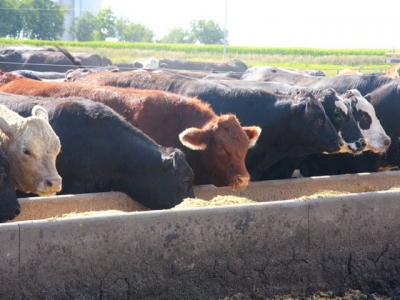New feeding model explored for US cattle feedlots

A new understanding of how to structure a gradual, restricted feeding program may improve returns for beef producers, says researcher.
Researchers at the University of Illinois explored the use of limit feeding as a way to improve producers’ profits by considering the influence of animal size, time in the feedlot and feeding rate, they said in a paper about their model.
The researchers used production and cattle growth data to establish a mathematical formula that provided a “profit-maximizing growth path,” which started with a period of progressive limit feeding followed by ad libitum feeding, they said. The system only worked financially when animals on the restricted diets were sent to market based on time rather than size – as they tended to be slightly smaller than non-limit fed animals.
The costs saved during the period of progressive feeding could be enough to offset slightly lighter cattle while generating profit for the producer, they said.
There are different ways to limit feed, said Michael Murphy, corresponding author and professor emeritus in the department of animal sciences at the University of Illinois. A method commonly used could be called “fixed percentage limit feeding,” where cattle are provided a percentage of a ration or less than they would eat if their feed was not limited.
If the amount of feed a growing animal receives is curbed, the animal’s maintenance requirements can shrink, he said.
“As an animal is growing, there are several organs responsible for heat production – two main ones are the liver and digestive tract – and those produce a large percentage of the total heat that the animal produces,” he said. “If they’re not needed for growth, if you start feeding them less those organs actually get smaller and reduce the requirement for maintenance. That’s why you can feed them less, and less, and less and still have them stay the same size.”
However, following a period of curtailed feeding, when the feed ration is increased the animal has a period of compensatory growth, Murphy said. Cattle will start to gain weight even if 100% of the initial ration is not provided or the cow will gain weight faster if ad libitum feed is provided.
“They call it compensatory growth because they’re compensating for having been held back,” he added.
The model provided an estimate of the improved profit that producers could see using the system.
Establishing the concept of progressive limit feeding started with research intended to establish a best or optimal path in terms of feeding, said Murphy.
“Optimum path programming is very challenging and really hasn’t been done much in animal science,” he said. “What we were trying to do [with this new approach is] minimize cost and maximize profit.
With their model, the amount the cows are fed continues to decline by a fixed percentage every day, Murphy said.
“Our way of doing it is actually prescribing a way to limit feed, so you feed them [about] 3.29% less – it’s progressive in that today it’s 96.7% and the next day you feed them less, and then less – you keep reducing it by 3.3 percentage units per day,” he said. “It’s not a constant 3.3% reduction, it’s a percentage of what they’re fed that day, they’re fed that much less the next day.”
Timing and duration of restricted feeding
The production practice raises two questions – when the best time is to restrict feed and how long should the restriction last, said Murphy.
Mathematically, the best time to establish a restricted feeding system with growing cattle is when they first enter the feedlot, he said. That gives the animals the most time to develop a carcass composition close to what it would have been if the system was not used.
It also reduces the “time value of money” because producers do not have to pay for the extra feed until closer to when animals are sold, he said.
“If you feed more, early, you’re paying more out early, and you don’t get any return until they’re slaughtered – you want to minimize your inputs,” Murphy said. “[With our model], you’re minimizing the time between paying for the feed and getting income from having shipped the animals."
However, cattle raised in a progressive limited feeding system for the same amount of time as non-limit fed cattle will be smaller when sent to the slaughterhouse, he said. Keeping limited fed cattle in the feedlot until they reach the same size as non-limit fed cattle means they will have to stay on feed longer.
“That cost will be more than the profit you would gain – so we have to be content with shipping a smaller animal, but hopefully one in which the carcass composition is pretty close to what they would be if they’d been ad libitum fed the whole time,” he said.
The length of time cattle are on a restricted feeding schedule is determined by examining feed cost and estimated carcass value, he said.
A new feeding trial further exploring this model is getting underway, Murphy said. The trial has a two-week progressive limit feeding period, but results will not be available until the spring.
Source: Journal of Animal Science
Authors: B. Hannon, M. Murphy
Có thể bạn quan tâm
 Dutch dairy consortium evaluating effectiveness of DSM methane inhibitor
Dutch dairy consortium evaluating effectiveness of DSM methane inhibitor The objective is to study the interaction between different diets and dosages of the feed additive on the level of methane reduction.
 Economist explores switching from dairy to beef
Economist explores switching from dairy to beef Years of tight profit margins and labor shortage led many Missouri dairies to switch to beef production.
 International partners to study endocannabinoid system in dairy cattle
International partners to study endocannabinoid system in dairy cattle Findings to serve as basis for development of novel strategies to alleviate metabolic stress as a contributor to disease.